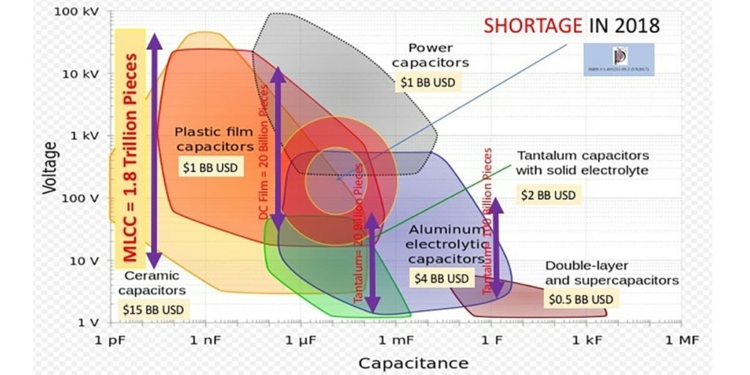Source: Paumanok blog
Plastic film capacitors are critical components used in power transmission and distribution grids; motors and drives; renewable energy systems, lighting ballasts, power supplies, microwave ovens, transportation, furnaces, welding machines, aircraft, medical defibrillators, logging tools, rail gun and high reliability electronics.
Plastic film capacitors are produced in a variety of configurations including radial leaded, axial leaded, SMD film chip; small can and large can configurations. Plastic film capacitors are also the oldest “dielectric” used in capacitor construction, as plastic film capacitors have been the primary power factor correction design for the original electrical grids, and in mass production as far back as 1901. Today, plastic film capacitors are largely defined as being either metallized polypropylene (PP) or metallized polyethylene terapthalate (PET).
In the fragmented, fast growing AC film capacitor segment, the markets, technologies and opportunities of polypropylene dielectric plastic film capacitors have been well documented in studies by Paumanok IMR over the past 30 years, including both dry and liquid-filled designs for use in electrical systems (power transmission and distribution capacitors; motor run capacitors, industrial drive capacitors; renewable energy capacitors; power film capacitors; microwave oven capacitors, magnetic ballast capacitors, and specialty power film capacitors (i.e. DC Link, furnace, traction, welding, other).
Additionally, Paumanok market and technology research also focuses on DC film capacitors for printed circuit board applications in power supply, lighting ballast, consumer AV and specialty/defense applications, and includes value and volume of demand for 5 mm pitch PET film capacitors; AC & Pulse film capacitors, interference suppression film capacitors and PPS, PEN and PET film chip capacitors; as well as specialty PTFE and polyimide film capacitors for consumption in high temperature electronics.
Because of extensive competition in the space due to ease of market entry, plastic film capacitor vendors are constantly attempting to decrease costs- here is a summary of how some plastic film capacitor vendors cut costs and increase profitability:
In-House Film Metalization:
Captive metalization of capacitor grade dielectric plastic film is an excellent way to increase profit margins and lower costs for capacitor manufacturers over time. An increasing number of AC and DC film capacitor manufacturers metallize their own thin films in-house, and in fact the vertical integration of plastic film dielectric from the merchant market into the capacitor market occurred first in the capacitor industry, with other dielectrics justifying their own vertical integration of materials from the merchant market into the captive market by pointing toward it being common practice in plastic dielectric films. This process saves the capacitor manufacturer premiums associated with buying metallized dielectric film directly from the merchant market.
In-House Film Extrusion:
Captive film extrusion has been noted in both AC and DC type plastic film capacitors, but Paumanok primary research has noted that the volume of captive extrusion of polypropylene exceeds that of all other plastic film dielectrics as some of the major producers of large can power transmission and distribution capacitors can extrude thin dielectric polypropylene film as well as metalize it. This decreases plastic film capacitor costs substantially. One of the major producers of large can plastic film capacitors has historically employed the “Tenter-Film” process to extrude dielectric films for decades. This process saves the capacitor manufacturer premiums associated with buying extruded dielectric film directly from the merchant market.
Low Cost Regional Production:
Another method of cost-savings employed by global manufacturers of plastic film capacitors includes the intentional production of large volumes of radial leaded plastic film capacitors in low cost production regions of the world (also with emphasis upon China, India and Malaysia).
Massive Economies of Scale:
Certain film capacitor manufacturers have large economies of scale within specific sub-categories of the plastic film capacitor industry. For example, many of the Asian vendors of plastic film capacitors have large economies of scale in the standard 5 mm metallized PET film capacitor segment because of their proximity to television set and audio equipment production in SE Asia. Meanwhile, in Europe for example, vendors have large economies of scale of more specialized types of plastic film capacitors, with emphasis upon interference suppression capacitors, safety capacitors and pulse discharge capacitors. On the polypropylene front the market remains highly fragmented, with only a few European and Japanese vendors with large economies of scale in motor run and related power film capacitors.































